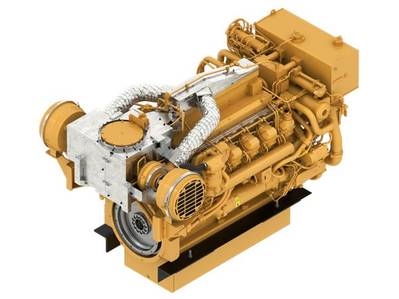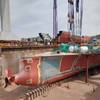First Caterpillar Methanol Dual-fuel Engines to Deploy in 2026
Caterpillar Marine announced plans to deploy its first set of field demonstrator methanol dual-fuel 3500E marine engines in 2026.
Cat 3500E marine engines will utilize innovative dual-fuel technology that leverages proven diesel fuel systems and supports vessels’ low-pressure – below 10 bar – fuel systems. The methanol dual-fuel Cat 3500E engine targets the same performance and durability as the current 3500E diesel engine while meeting emission standards and delivering 100% power.
Following significant advances in the development of this technology, the engine manufacturer announced it has signed a memorandum of understanding (MOU) with Damen Shipyards Group for the 2026 trials.
“We’re leveraging our deep dual-fuel expertise to help reduce emissions in the maritime industry,” said Brad Johnson, vice president and general manager of Caterpillar Marine. “We look forward to putting the first Cat 3500E demonstration engines in the water with Damen Shipyards in 2026.”
“We’re expanding the 3500E platform’s fuel flexibility to provide customers with a wider array of options to navigate the energy transition,” said Andres Perez, global tug segment manager at Caterpillar Marine. “Fuel flexibility is key to future-proofing assets. This technology will enable owners to adopt their fuel of choice when the conditions are right without having to build a new asset or face cost-prohibitive retrofits.”
“Our dual-fuel Cat 3500E marine engines are optimized to achieve high methanol substitution rates over a wide range of load factors, including the low load ranges that tugs operate in most of the time,” said Will Watson, global product director at Caterpillar Marine. “For example, a 28-meter tug transiting at 8 knots requiring only 600 kilowatts (kW) of propulsion power would target to achieve a methanol substitution on an energy basis above 70%. This will enable operators to reduce greenhouse gas emissions while experiencing the power and performance they're accustomed to,” said Watson.
The methanol dual-fuel 3516E engine development takes a holistic approach, targeting the highest methanol substitution while meeting regulated emissions, Caterpillar Marine said. Non-regulated emissions, such as formaldehyde, are part of the focus, and the IMO III solution will abate regulated and non-regulated emissions, targeting the same aftertreatment space claim.












